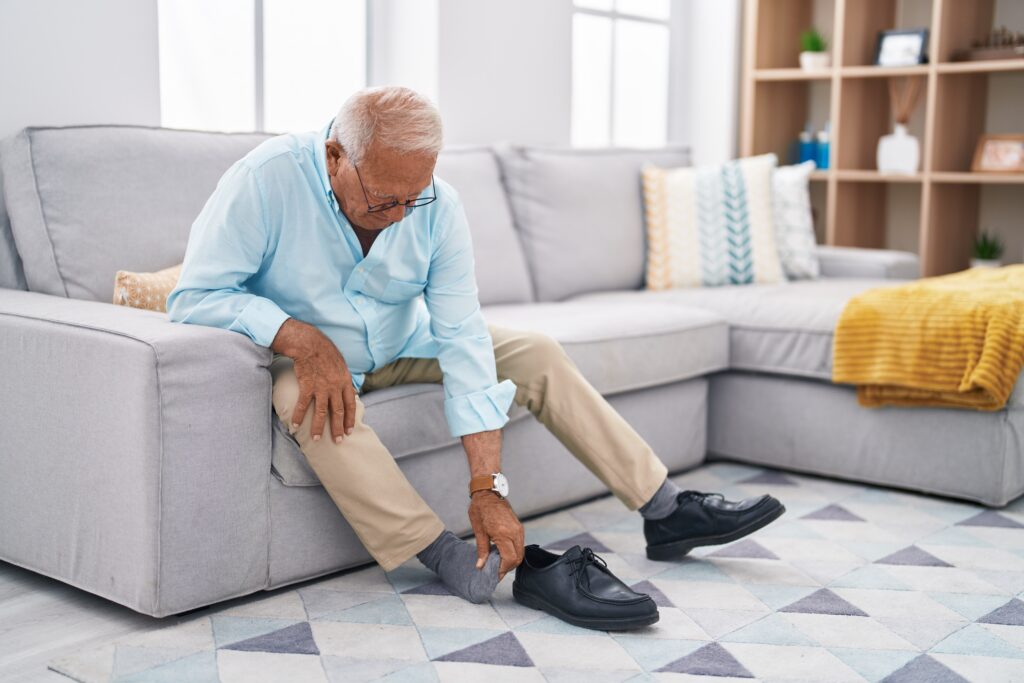Swelling of the feet in older people is a common phenomenon that can derive from various causes, generating discomfort and affecting quality of life. As we age, our body undergoes physiological changes and various factors can contribute to fluid retention, leading to swelling in the feet and ankles.
This problem can be both a symptom of underlying medical conditions and a natural response of the body to certain lifestyle habits. Understanding the possible reasons behind swollen feet in older people is essential to effectively address the problem and improve overall well-being.
Why do older people's feet swell?
Swelling of the feet and legs in older people can be due to a variety of factors, and understanding these causes is crucial to effectively addressing the problem. As we age, the body experiences changes in blood circulation, heart function and other physiological aspects that can contribute to fluid retention.
Here are some of the most common causes of swelling in the feet and legs in older people:
- Venous insufficiency: The ability of the veins to carry blood back to the heart may decrease with age, leading to fluid accumulation in the lower extremities.
- Heart problems: Heart disease such as heart failure can affect the heart's ability to pump blood efficiently, leading to fluid accumulation in the extremities.
- Kidney failure: Kidney problems can lead to sodium and water retention, contributing to swelling in the feet and legs.
- Lack of physical activity: Inactivity can hinder venous return and lymphatic drainage, favoring fluid accumulation in the lower extremities.
- Arthritis: Conditions such as arthritis can cause inflammation in the joints, affecting circulation and contributing to swelling.
- Obesity: Excess weight puts additional pressure on the lower extremities, affecting circulation and favoring fluid retention.
- Medications: Some medications, such as antidepressants, blood pressure medications and corticosteroids, can have side effects that contribute to swelling.
- Prolonged posture and position: Maintaining a sitting or standing position for prolonged periods of time can hinder venous return, favoring the accumulation of fluids in the feet and legs.
Injuries or surgeries: Injuries, surgical procedures or orthopedic problems can affect circulation and contribute to swelling.
Why does edema occur?
Edema is the abnormal accumulation of fluid in body tissues, leading to swelling and expansion of the affected area. This condition can manifest itself in different parts of the body, such as the feet, legs, arms or even in more internal areas, such as the lungs.
Edema formation is mainly due to an imbalance in body fluids, where the amount of fluid entering the tissues exceeds the amount that the lymphatic and venous systems can adequately drain and eliminate.
The causes of edema are varied and include factors such as water retention due to circulatory problems, heart failure, kidney disease, lymphatic disorders, swelling due to injury or infection, as well as the influence of certain medications.
What are the most common symptoms of swollen legs in older people?
Swelling in the legs is a common concern in the elderly, and recognizing the associated symptoms is essential to addressing any underlying problems. The most common symptoms of swollen legs in older people may include:
- Edema: Visible increase in the size of the legs due to fluid accumulation in the tissues.
- Purple coloration or redness: There may be changes in the coloration of the skin, manifesting as a purple or reddish tone, indicating possible circulatory problems.
- Swelling in the ankles: Fluid accumulation often manifests itself first in the ankles, causing swelling and a feeling of heaviness.
- Pain or discomfort: Swollen legs may be accompanied by pain, discomfort or a feeling of tension in the affected area.
- Feeling of warmth: The skin on the legs may feel warm to the touch due to the inflammation associated with the swelling.
- Limited mobility: Significant swelling can affect mobility, making it difficult to walk or perform daily activities.
- Ulceration: In more severe cases, chronic swelling can lead to the formation of ulcers on the skin, especially around the ankles.
Changes in skin texture: There may be changes in skin texture, such as dryness or flaking, as a result of persistent swelling.
How to avoid swollen feet and legs in the elderly?
Swollen feet and legs in seniors can be a challenge, but adopting healthy lifestyle habits and taking preventive measures can help reduce this common problem associated with aging. Here are some tips for avoiding swollen feet and legs in seniors:
- Keep active: Regular physical activity, such as walking or low-impact exercise, promotes blood circulation and helps prevent fluid accumulation.
- Elevate the legs: Elevating the legs above the level of the heart for short periods of rest can facilitate lymphatic drainage and reduce swelling.
- Avoid a sedentary lifestyle: Avoid remaining in a sedentary position for prolonged periods of time, getting up and moving around from time to time, helps to maintain proper circulation.
- Weight control: Maintaining a healthy body weight reduces pressure on the lower extremities, reducing the risk of swelling.
- Wear comfortable shoes: Wearing comfortable, supportive footwear helps prevent circulatory problems and improves comfort during physical activity.
- Limit sodium intake: Reducing sodium intake in the diet can help control fluid retention, reducing swelling.
- Drink enough water: Although it may seem paradoxical, maintaining adequate hydration can help prevent fluid retention by stimulating the renal system.
- Avoid long exposures to heat: Avoid staying too long in hot environments or saunas, as heat can contribute to dilation of blood vessels and swelling.
- Follow medical recommendations: Complying with medical treatments and recommendations for chronic conditions, such as heart or kidney problems, can help prevent associated swelling.
- Consult a health care professional: In the presence of persistent swelling, it is crucial to seek the guidance of a health care professional to evaluate and address any underlying problems early.
In conclusion, the prevention of swollen feet and legs in the elderly involves the adoption of healthy practices and continuous attention to circulatory health. However, in situations where assistance and constant monitoring are essential, SICOR telecare El Corte Inglés emerges as a valuable resource.
Offering a remote care service, SICOR telecare El Corte Inglés provides instant support to the elderly, enabling a rapid response to any circulatory health concern or any other problem.

